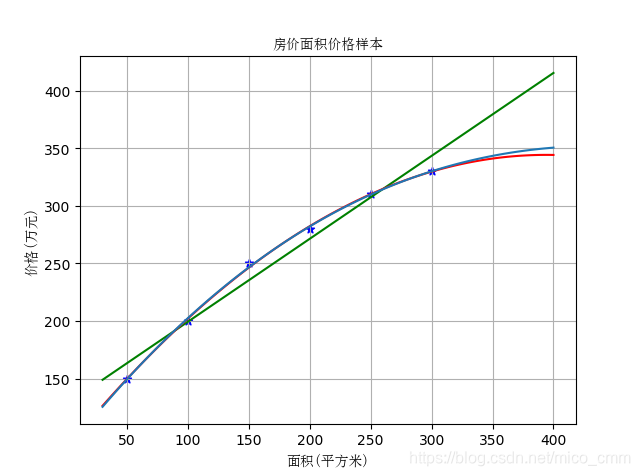版权声明:本文为博主原创文章,未经博主允许不得转载。 https://blog.csdn.net/mico_cmm/article/details/86927451
对于给出的 数据做出散点图,可以大致看出模型是否适合做线性回归,但是,线性回归一定是拟合最好的模型吗?答案是否定的。有时候,多项式回归会得出拟合效果更好的模型,但是也需要注意过拟合的线性。
下面,还是以房屋面积预测房屋价格的数据为例:
读取数据,绘制散点图:
多项式回归
import matplotlib.font_manager as fm
import matplotlib.pyplot as plt
from sklearn import linear_model
import numpy as np
from sklearn.linear_model import LinearRegression #导入线性回归模型
from sklearn.preprocessing import PolynomialFeatures # 导入多项式回归模型
# 字体
myfont = fm.FontProperties(fname='C:\Windows\Fonts\simsun.ttc')
# plt.figure() # 实例化作图变量
plt.title('房价面积价格样本', fontproperties = myfont) # 图像标题
plt.xlabel('面积(平方米)', fontproperties = myfont) # x轴文本
plt.ylabel('价格(万元)', fontproperties = myfont) # y轴文本
# plt.axis([30, 400, 100, 400])
plt.grid(True) # 是否绘制网格线
# 训练数据(给定的房屋面积x和价格y)
X = [[50], [100], [150], [200], [250], [300]]
y = [[150], [200], [250], [280], [310], [330]]
# 做最终效果预测的样本
X_test = [[250], [300]] # 用来做最终效果测试
y_test = [[310], [330]] # 用来做最终效果测试
# 绘制散点图
# plt.plot(X, y, 'b.')#点
# plt.plot(X, y, 'b-')#线
plt.scatter(X, y, marker='*',color='blue',label='房价面积价格样本')
# plt.show()先做出线性模型:
# 线性回归
model = LinearRegression()
model.fit(X,y)
# 模型拟合效果得分
print('一元线性回归 r-squared',model.score(X_test,y_test))
x2=[[30],[400]] # 所绘制直线的横坐标x的起点和终点
y2=model.predict(x2)
plt.plot(x2,y2,'g-') # 绿色的直线
# plt.show()做出二项式回归模型,看拟合效果,同线性模型进行比较:
# 二次多项式回归
# 实例化一个二次多项式特征实例
quadratic_featurizer=PolynomialFeatures(degree=2)
# 用二次多项式对样本X值做变换
X_train_quadratic = quadratic_featurizer.fit_transform(X)
# 创建一个线性回归实例
regressor_model=linear_model.LinearRegression()
# 以多项式变换后的x值为输入,带入线性回归模型做训练
regressor_model.fit(X_train_quadratic,y)
# 设计x轴一系列点作为画图的x点集
xx=np.linspace(30,400,100)
# 把训练好X值的多项式特征实例应用到一系列点上,形成矩阵
xx_quadratic = quadratic_featurizer.transform(xx.reshape(xx.shape[0], 1))
yy_predict = regressor_model.predict(xx_quadratic)
# 用训练好的模型作图
plt.plot(xx, yy_predict, 'r-')
X_test_quadratic = quadratic_featurizer.transform(X_test)
print('二次回归 r-squared', regressor_model.score(X_test_quadratic, y_test))
# plt.show() # 展示图像
得到图像:

红色的线就是二项式的回归模型,可以看出它是比线性回归模型对本案例的数据拟合效果要好一些,二者的拟合效果得分分别为:

那么,当前的二次回归是否是最好的呢?我们再做三次回归看一下:
# 三次回归
cubic_featurizer = PolynomialFeatures(degree=3)
X_train_cubic = cubic_featurizer.fit_transform(X)
regressor_cubic = LinearRegression()
regressor_cubic.fit(X_train_cubic, y)
xx_cubic = cubic_featurizer.transform(xx.reshape(xx.shape[0], 1))
plt.plot(xx, regressor_cubic.predict(xx_cubic))
X_test_cubic = cubic_featurizer.transform(X_test)
print('三次回归 r-squared', regressor_cubic.score(X_test_cubic, y_test))
plt.show() # 展示图像得到的图形为:

从图形来看,它和二次回归模型的拟合效果不相上下,分辨不出孰好孰坏,下面看一下拟合得分。
图形模型拟合效果得分为:

可以看出,三次回归的模型拟合得分比二次回归高,但是相差不多,从图形看来二者拟合效果都很好,因此我们在此种情况下选择二次回归,原因为三次回归可能出现了过拟合的现象。